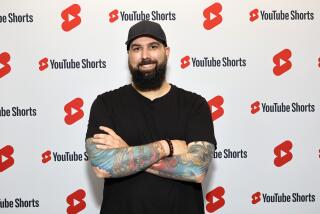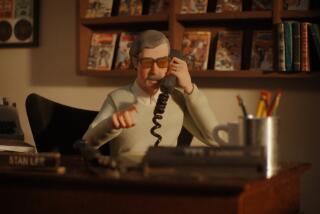Getting boys to read all about it
- Share via
NEW YORK — Books have to compete with video games, DVDs, CDs, PCs and iPods when it comes to filling children’s free time, and since books don’t beep, flash or call attention to themselves in some other noisy way, they can be easily overlooked by today’s joystick generation.
But if books did try to play on the same action-packed, visually stimulating field, could young readers be seduced?
Stan Lee, the cartoonist who created popular Marvel superheroes such as Spider-Man, the X-Men and the Incredible Hulk, did it with the kids who are now today’s parents when pleasure reading was threatened by movies and television.
He’s now putting his support behind upstart publisher Big Guy Books, whose primary product is the “Time Soldiers” series. The books do their best not to look like traditional grade-school books: The pages are glossy, the fonts mimic those used to type e-mail or instant messages, and the illustrations are a blend of realistic photographs and computer-drawn dinosaurs, mummies and pirates -- all framed as if readers were reading the story through the lens of a camcorder.
“It’s a lot like movie special effects,” explains Robert Gould, Big Guy’s founder.
Gould, a former photo illustrator and graphic designer, wanted to create books that would cater to “reluctant readers,” often children -- and even more often boys -- who fall between primary-color picture books and young-adult chapterbooks.
(Gould just happens to be a father of two boys who were spending an increasing amount of time in front of flat screens.)
The “Time Soldier” books move quickly, using almost all dialogue between the characters, who go on various adventures through a time portal.
“We’ve got six kids who find a door to the world of adventure. What little boy wouldn’t want to explore inside? It’s an arrow aimed at the heart of every little boy of every boy I’ve ever known,” says Kathleen Duey, author of the books.
“We knew that if you could incorporate some elements of videos and video games, it would work,” she says. “The ‘Time Soldiers’ are based on Robert’s kids and their friends. They’re average-looking children who find a time portal, and then try to explain it to their parents, who, of course, don’t get it. They’re ‘everykid’ adventures that every kid can relate to.”
That’s one of the parallels between “Time Soldiers” and Lee’s comics, says Duey, because Lee always tries to appeal to the broadest audience possible with splashy graphics and a progressive style without ever dumbing down the story.
“I used college-level vocabulary in Marvel comics even though I was targeting a younger audience. They [young readers] would want to know what the words meant. They might learn from the context, maybe from osmosis and it’s not the worst thing if they had to look up a word in the dictionary,” Lee says. “Young brains are like sponges. The more you give them, the more they absorb.”
Similarly, “Time Soldiers” books feature at least 100 new vocabulary words per book. Lesson guides are also offered to teachers and librarians.
Authors, illustrators and publishers are going to have to evolve with today’s children if they are going to keep them interested in books, which are so important in teaching literacy and other lifelong lessons, Lee says.
“When I was young, you were lucky to get to a movie once in a while. The rest of the time you were reading books or playing outside,” he says, but things have changed and they’re not going back. Children today are looking for the next greatest thing, and it could be books if they’re made even more interesting and stimulating than their other distractions, according to Lee.
“We hope it looks like pure ‘Flash-Bam’ entertainment because it’s absolutely designed to draw in boys who would not otherwise read,” Duey says.
That’s the rub with critics, though. According to Gould, booksellers in particular complain that the “Time Soldier” books don’t look like “literature.”
“That’s the point!” he says.
More to Read
Sign up for our Book Club newsletter
Get the latest news, events and more from the Los Angeles Times Book Club, and help us get L.A. reading and talking.
You may occasionally receive promotional content from the Los Angeles Times.








